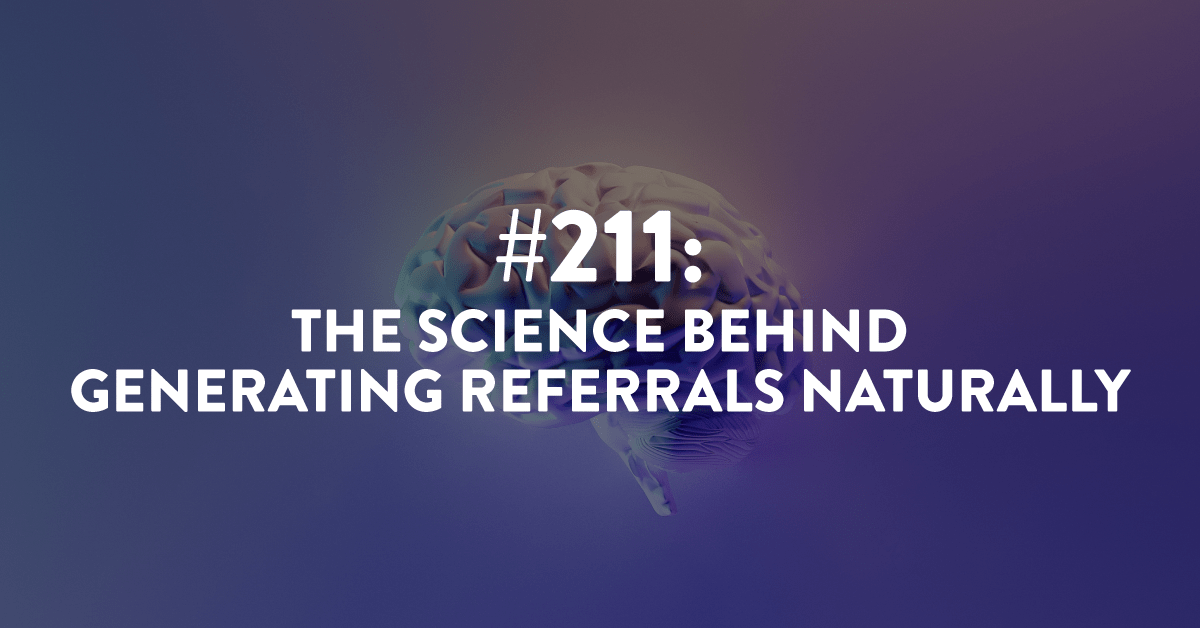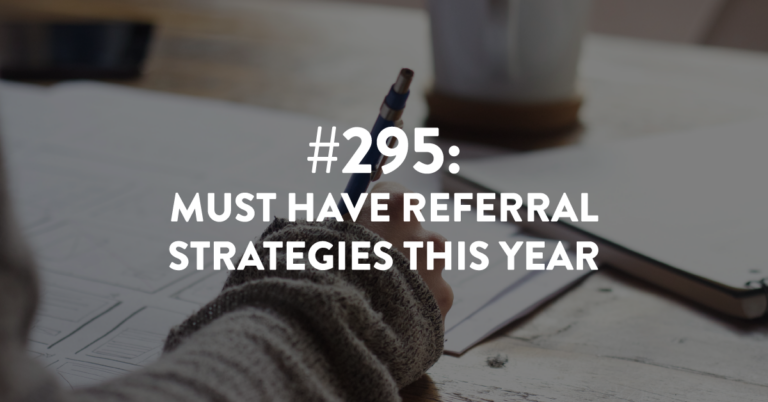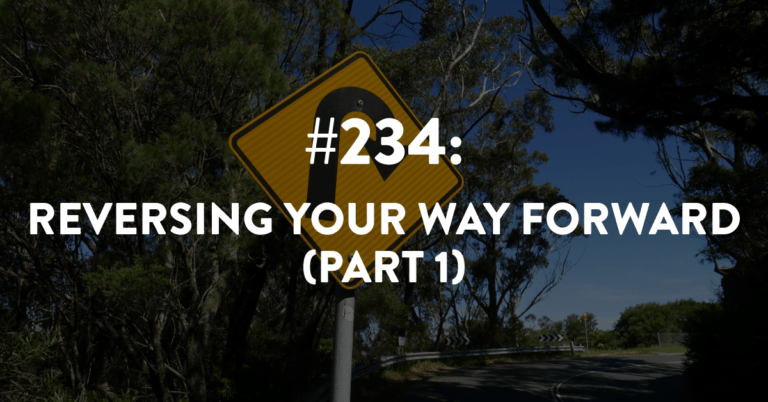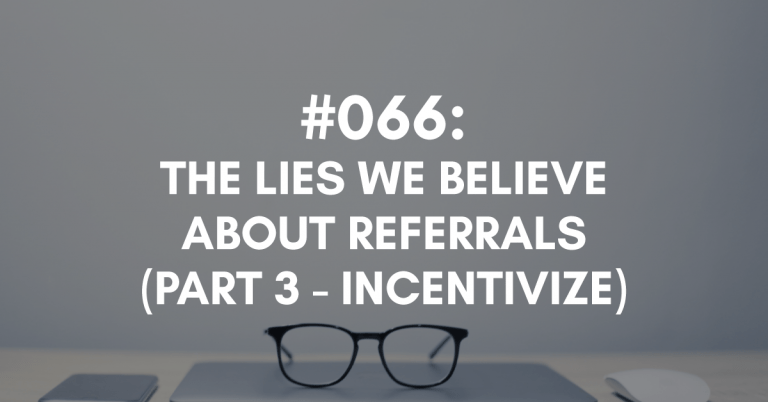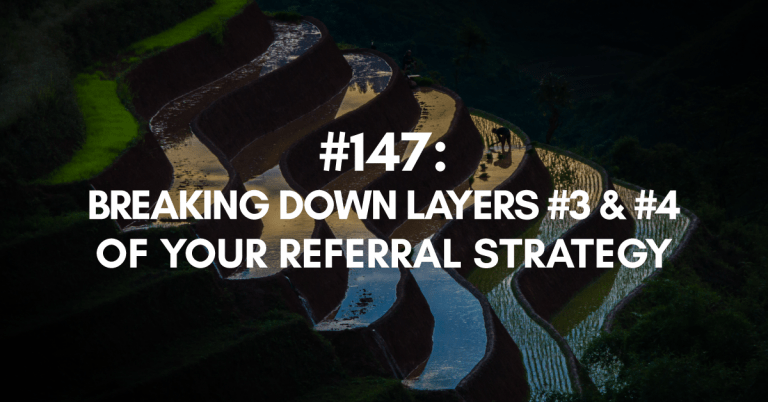Ep #211: The Science Behind Generating Referrals Naturally
Did you know that there’s a science behind referrals?
In this episode, I’ll be walking you through a few key points about this science. You will get to hear about the specific method I use to generate referrals and get a better understanding of how it works. You’ll also get the full breakdown of how science influences my strategy and learn three specific keys to generating referrals naturally.
Listen in for insight into the methods I use, as well as how they encourage a positive response from referral sources. From why referrals aren’t about you to the importance of how you connect to your referral sources, this episode will provide clarity on why these methods work so well.
Links Mentioned During the Episode:
- Episode #202, Interview with Erica Young
- Episode #203, Breakdown of Erica’s research as it relates to referrals
- Referrals Without Asking Facebook Group
- Building a Referable Business
Looking for Referral & Client Experience Resources:
Take the Referral Ninja Quiz to test your skills and abilities at generating referrals. (FREE)
Buy my book – Generating Business Referrals Without Asking – and learn how to generate referrals through my 5 steps. (LESS THAN $16)
Consider joining Building a Referable Business™ – a unique way to learn all of my referral strategies and tactics with ongoing weekly access to me to answer your questions and help hold you accountable! Email me for more details.
Coming Up:
Next episode is #212, and we’re kicking off our summer series with all things business development.
Download The Full Episode Transcript
Read the Transcript Below:
Stacey Brown Randall: Do you know there’s a science behind referrals? That’s right. Whether used for good or evil, there is a science behind it, and in this episode, I’m going to break it down for you.
You are not just another hustling salesperson. You are the expert, the
resource, the valuable partner for your clients, and how you grow your
business should reflect how your clients see you.
Welcome to the Roadmap to Grow Your Business podcast. We generate
referrals without asking, build positive client experiences, and help
you take control of your business.
Here’s your charmingly sarcastic host, Stacey Brown Randall.
Stacey Brown Randall: Hey there, and welcome to Episode 211 of the Roadmap to Grow Your Business Podcast. I’m your host, Stacey Brown Randall.
I got a quick shout out for our financial advisor Joel, who I’m super proud of. I just want to share the results he has had being a member of our Growth by Referrals and Referring Machine programs.
So, when he started about six months ago, he set a goal to receive 17 referrals. Great goal, right? Considering the fact that I tell folks if you’re earning or receiving less than 10 referrals in a year, we usually want to try to double whatever number you are receiving.
So, he set his first-year goal at 17. Guess what? In six months, can you guess how many referrals he’s received? Well, if you said 16, you’d be right. In six months, he’s one away from hitting his one-year goal, which means he’s actually on pace to double his goal.
Joel, congratulations. Nothing warms my heart more when someone comes into the program and trust the process, and then of course, does the work, so they then have success to share with me and I can share it with you. Congratulations, Joel.
Okay. Let’s dive in to today’s episode. Did you know that there’s a science behind referrals? It’s true. In this episode, I want to walk you through a few key points about this science. Now, this science that I’m going to teach to you today is very specific to how I teach you to generate referrals.
Some other referral methods and tactics use science too, like teaching you to take advantage of reciprocity when you ask your clients for referrals, which side note, personal opinion, I think that’s pretty horrible, by the way. Or others will teach you to leverage recency bias with keep-in-touch tactics like emailing or texting or mailing a card or dropping by every 30 days, so you’re keeping in touch all the time.
Those tactics are using science as well. And just for the record, because I just feel like I’m going to say this now and I’m probably going to repeat myself a few more times to make sure I am uber-clear with this; for the record, I am very much against manipulative or disingenuous tactics.
Personally, I just don’t think they make us good people, and I don’t think our referral sources deserve that type of behavior or actions from us. So, just as some use science for evil, others use it for good.
So, what I want to do is break down for you the three ways that science influences my strategy of what I teach when we generate referrals naturally. I want to break down for you these three ways within my methodology that help you generate referrals naturally, which means in a way that will work for you and in a way that your referral sources will positively respond to.
Now, here’s the thing, by the way, there’s not only three like scientific or science pieces that are … there’s not only three, I guess I should say, within my methodology — but these are the three big ones. There’s definitely some other pieces that are mapped throughout it and I’m going to try really, really hard in this episode not to put like my adjunct professor hat on and like bore you with all the academic science stuff.
I actually mapped out this episode on purpose, so I would stay on point and give you the big picture of these three ways that science influences the way that I teach generating referrals.
And for my clients, if you’re in any of my programs and you’re thinking as you listen to this episode, “Wait, I haven’t heard this before.” It’s because I teach you what to do and say, based on the science within my programs without weighing you down in the science.
So, what I mean by that is, is that my methodology is taught based on these scientific principles, but I don’t break them down for you point by point. I mean you recognize some of them, but I don’t break them down for you point by point within my programs, because I don’t want you to get bogged down in that.
I want you to learn what you need to learn, to take the right actions and to have the results that you deserve. So, if you are a client of mine, if you’re in Building a Referral Business or Growth by Referrals or Referring Machines, and you’re like, “Wait, I’ve heard part to this, but not all of this,” there is definitely a reason for it, and that’s because I want to make sure you don’t get bogged down in all the details. What you need when you’re in one of my programs is a clear plan of action and that’s what these programs give you.
So, here are the three ways that science influences my generate referrals naturally methodology. You’ve probably heard me say at some point, if you’re a longtime listener of this podcast, or you’ve just watched a lot of my videos or read my book or just been hanging out in my world for any length of time — you’ve probably heard me say referrals aren’t about you.
And I believe that that is one of the major ways that what I teach is different from the other people who teach referrals. Because clear as day, I state referrals aren’t about you. But a lot of the other tactics that people teach when it comes to generating referrals, they come from a place of feeling and believing like referrals are about you, and so their tactics represent that.
But I look at referrals through what’s called the happiness trifecta. Have you ever heard this? But the happiness trifecta is when a referral source knows somebody, a prospect, that has a problem, and they are going to connect that prospect who has a problem with you to help out the prospect.
And so, when the referral source is being the hero of helping somebody who has a problem by connecting them with you, as the solution provider, it triggers their happiness trifecta, which of course, is three chemicals in the brain that are known as the feel-good chemicals. That’s dopamine, serotonin, and oxytocin.
I don’t think I said that right — oxytocin (I think I said it wrong again). Anyways, you guys know what I’m trying to say. I’m not going to belabor this point or go back and edit that. I’m just going to say those three chemicals in the brain are triggered because they’re the feel-good chemicals.
And when we’re helping someone, those chemicals are triggered. When someone says I’ve got a problem, think about it — when someone says, “I have a problem,” you instantly usually go into the mode of, “Oh, let me help you solve it if I can.” Right, and that keeps the referral source, having that happiness trifecta kind of triggered in their brains, feeling like the hero and feeling good.
The happiness trifecta is triggered and released when we are helping someone, and we’re helping someone who has a problem. And guess how we’re going to help them? By referring them to you because you can solve their problem and make me look good in the process.
And that is what’s ultimately happening when somebody refers someone to you. And I would add to that the correct way. The way in which that prospect shows up, knowing they have a problem, trusting you to solve it because they trust the referral source and they actually are interested in solving their problem.
Which is why they’re willing to be connected to you in the first place, which makes that referred prospect just a better prospect because they show up trusting you, they’re easier to close, quicker to close, and typically, they’re less price sensitive if they’re the right fit for your business.
So, when you think about this first piece of what happens when referrals are being made, it’s not about you. Yes, you get a new client and that feels amazing for you. And yes, definitely, I’m pretty sure your referral source feels pretty good about referring to you too, but that’s not really what triggers the happiness trifecta. That is triggered when they know somebody who has a problem and they get to be that person’s hero by connecting them with the solution provider. And you my friend, never forget, in this scenario, you are the solution provider.
Okay, so that’s one, number two: this should really go without saying, but I find I have to say it a lot. Relationships run on trust. I know you know that. Like I know, and for my long-time listeners, you’re like, “Yep, check the box, I know that one’s super, super important.”
But the reality of it is if you look at it from a science perspective of the psychology of trust and what that means within a relationship where we put our reputation on the line to refer someone to you, and then you look at that from the perspective of your social networks and the strength of those social networks, and in this case, a social network being your network of referral sources — when you look at how all of that combines, so the science behind social networks and the psychology of trust, it’s a huge driver in terms of that relationship. Because trust between people is what fuels the relationship, the depth of that relationship.
And I said before, so I’ll say it again, in business, trust is the real currency and relationship’s the economic driver. It’s important for you to recognize that when you think about trust, trust is not just the thing that maybe your parents or some mentor told you was super important, people should trust you. You should do the right thing. Do what you say you’re going to do — do the right thing, people need to be able to trust you.
Yes, all that’s right. But when you think about somebody referring somebody else to you, it really comes down to how well they trust you. That’s also going to be defined by how well they set you up when they’re talking to the prospect about you. And what they say is going to come down to the level of trust they have in you.
So, if you’ve never done any research on the psychology of trust, it’s worth a Google search just to kind of check it out in terms of how powerful and how important it is. It’s common sense on some level. Yep, we know trust is important. We all know that. Most of us are usually raised with that as an important kind of metric in our lives, but it actually plays in to our business relationships as well.
And we talked about this with social networks, when Erica Young was on the podcast in Episode 202, I interviewed her and we talked about the research that she does around social networks and some of the other things that she does regarding our communities within our businesses.
And then I came back in Episode 203, and I kind of gave an overview of what that looks like from a referral perspective. So, if you haven’t heard those episodes, I would recommend you go listen to them. It’s Episode 202 and 203. I’ll link to it in the show notes for this episode and of course, the show notes for this episode is staceybrownrandall.com/211. That’s 2-1-1, 211, and Stacey has an “E.”
So, it’s really important that you understand trust I think matters in every relationship you have, of course. And of course, it’s never absent in our business relationships either. It’s another important one for you to always keep in mind.
And the trust you have with your referral sources matters. But the trust you have with your referral sources isn’t just because when they refer you, you do a good job. It’s everything about that relationship. It’s how you communicate, it’s how you close the loop. It’s how you take care of them in between them actually giving you referrals and of course, how you think for the referrals they send you.
It’s all of that additional stuff that deepens and strengthens the relationship you have with them. And trust is huge. So, that’s our second point. Let’s move on to our third point.
The third way that science influences the way I teach referrals is how you connect and care for your referral sources, whether you have 5 or 55 of them. How you connect and care for your referral sources is directly related to your consistency of receiving referrals.
Now, this one has a few layers to unpack, and so I’m going to stay at the 30,000-foot view because I don’t want to, again — I promised myself and you, I wouldn’t put on my adjunct professor hat and I wouldn’t like dive into all things science and data and geek out with you, though some of you may enjoy that, some of you not so much.
So, I’m going to stay at a high level here and kind of give you an overview. But when you think about connecting and caring with your referral sources, and that’s directly related to your consistency of receiving referrals; this actually, the part of science that comes into play with this is actually behavioral economics.
Now, there is a lot of different things in behavioral economics where people take things and they use them to manipulate or they take things and they use them for good. Reciprocity is probably the first one that came to mind because it’s always the first one that comes to mind to me.
Reciprocity is absolutely a part of behavioral economics. Some people teach you to take advantage of that, to leverage that, to manipulate that: when the client’s feeling good, then go in and ask for their referral. It’s like, “Hey, when the client’s feeling good, then go in and ask for the kill.” Like that kind of stuff.
And then there’s the way to use reciprocity in a different way, in a positive way. And that’s the way that I look at it. I would never teach anyone nor do I teach or believe that anyone should ever leverage reciprocity because ooh, someone feels good about me. Now, I should just go in and get my referrals.
But knowing when you take care of people correctly, when you connect with them, when you are caring for them, that reciprocity is obviously fostered and it’s recognizing that and understanding that.
And if the case is, if they’re able to refer you from that reciprocity place, great, but there’s no expectation of it because nobody can snap their fingers and say, “Yep, I was nice to you. Now, give me a referral.” Like that’s just not how it works.
But understanding when you have a system or a plan in place to take care of your referral sources, that naturally reciprocity is being built. We recognize that and we do not use it to our advantage. That’s really important. But we do recognize that it happens.
Another part within behavioral economics is the surprise and delight factor. The idea that what we do for our referral sources … we’re not paying them every time they refer us where they know a payment is coming. It’s a surprise and delight factor of how we’re going to connect with them and how we’re going to care with them. And that’s built into how we build out our plan.
And so, of course, there are other pieces and parts that really come into how behavioral economics work within the strategies that I teach, and behavioral and economics are like this is something that’s been taught and researched for decades. None of this is new. It’s like understanding the science of persuasion.
When people are studying persuasion, there’s like social proof. There’s different things that you know that you need to be paying attention to when you’re trying to persuade someone to do something. It’s no different with behavioral economics, but it’s looking at those pieces of it and using it for good, and recognizing what’s happening and recognizing where you don’t take advantage of something so that you can always, always, always, always honor and respect the relationship you have with your referral source.
Because remember, there’s a human on the other side of everything we’re doing and we need to protect that relationship with that human and we have an obligation to do what’s right by them.
And so, when we look at these three pieces of science and how they all play together: the happiness trifecta, the psychology of trust with social networks, and behavioral economics — all of that comes together to allow us to do something that is authentic and genuine. But recognizing there is a science behind it and how it ultimately works.
Your approach to generating referrals really should be reflected in what’s making the referrals happen. My methodology and process, which I teach through generating referrals naturally, really does combine the happiness trifecta, the psychology of trust, and behavioral economics, plus a few other things that we didn’t have time to get into, which leads to more referrals in an authentic way, a genuine way, leads to more referrals naturally.
But here’s the thing, as I mentioned, as kind of like an aside for my current clients, hey, if you’re hearing me say things you’ve never heard me say before, it’s because I don’t get you bogged down in the science when I’m teaching you my methodology.
I take the science back solution that I’ve created and now have been working with people over a decade and had tons of success with them — my clients have tons of success. I take that science back solution and I make it practical for you an application.
Which means at the end of the day, I may not teach you all the pieces of the why behind everything that I teach you, but you know it’s all baked into it being scientific. It’s all based on science. It’s all based on how we use everything for good. Nothing for evil of how we take care of people who take care of our business.
And yes, a lot of this is pure common sense, but even some pure common-sense stuff is actually rooted in science, something for us always to remember.
So, here’s the thing, what you do for your referral sources, what you say to your referral sources, and how often you connect with your referral sources, you need it all to build consistency of referrals. And it’s no different if you don’t have a lot of referrals and you need to develop new people into referral sources.
People who’ve never referred you before, we use that same piece of science, differently though, because these people have never referred us before, to actually cultivate them into a brand-new referral source for us.
So, all this science, it winds itself all the way through everything that I teach, from the referable client experience to turning clients and contacts into referring machines, to how we grow by referrals, to get more referrals from our existing referral sources.
But here’s the number one thing I want you to walk away with. I know we talked about a lot of stuff, I personally believe it’s all good stuff, but here’s the one thing I want you to know and hold fast to and hold us truth in your heart. When it comes to referrals, above all, how you go about generating referrals should feel right to you and it should work, period! How you go about getting referrals should feel right to you and it should also work for you.
I would love to know your thoughts on this episode. If you would hop into our free community over on Facebook, Referrals Without Asking, and let me know what you think.
If you’ve never thought about the science behind what I teach and how referrals work and how we go about generating them naturally, I would love to get your reactions, your thoughts, and your questions. Hop into our Referrals Without Asking Facebook group. It’s a free community over on Facebook, where you can join us and ask your questions.
And I will link to the community, to that Facebook group community, Referrals Without Asking on the show notes page of this episode. And of course, the show notes page for this episode is staceybrownrandall.com/211. That’s for episode 211 and you know it, Stacey has an “E.”
Coming up next week is episode 212. Guess what? We’re kicking off our summer series. That’s right. As we get ready to kick off July, we are kicking off another summer series where I take one topic and I just go deep with it over a course of weeks throughout the rest of summer.
And what’s our topic this time around? Well, you’ve probably heard me talk about it already on the podcast before, as I’ve been asking you guys to submit your questions, to submit your topics, to submit the areas you want me to go into. So, what is this topic? Business development.
That’s right. We are digging in to all things business development. We’re going to talk about sources, we’re going to talk about messaging, we’re going to talk about sales process. We’re going to talk about buyer’s journey, we’re going to talk about all the things. Can’t wait.
Until then my friend, you know what to do; take control and grow your business. Bye for now.
Thanks for listening to the Roadmap to Grow Your Business podcast. To
access all resources and links mentioned in today’s show, and to
connect with Stacey, head over to www.staceybrownrandall.com.

